Xueyang Zhang
GeoDrive: 3D Geometry-Informed Driving World Model with Precise Action Control
May 29, 2025Abstract:Recent advancements in world models have revolutionized dynamic environment simulation, allowing systems to foresee future states and assess potential actions. In autonomous driving, these capabilities help vehicles anticipate the behavior of other road users, perform risk-aware planning, accelerate training in simulation, and adapt to novel scenarios, thereby enhancing safety and reliability. Current approaches exhibit deficiencies in maintaining robust 3D geometric consistency or accumulating artifacts during occlusion handling, both critical for reliable safety assessment in autonomous navigation tasks. To address this, we introduce GeoDrive, which explicitly integrates robust 3D geometry conditions into driving world models to enhance spatial understanding and action controllability. Specifically, we first extract a 3D representation from the input frame and then obtain its 2D rendering based on the user-specified ego-car trajectory. To enable dynamic modeling, we propose a dynamic editing module during training to enhance the renderings by editing the positions of the vehicles. Extensive experiments demonstrate that our method significantly outperforms existing models in both action accuracy and 3D spatial awareness, leading to more realistic, adaptable, and reliable scene modeling for safer autonomous driving. Additionally, our model can generalize to novel trajectories and offers interactive scene editing capabilities, such as object editing and object trajectory control.
PosePilot: Steering Camera Pose for Generative World Models with Self-supervised Depth
May 03, 2025Abstract:Recent advancements in autonomous driving (AD) systems have highlighted the potential of world models in achieving robust and generalizable performance across both ordinary and challenging driving conditions. However, a key challenge remains: precise and flexible camera pose control, which is crucial for accurate viewpoint transformation and realistic simulation of scene dynamics. In this paper, we introduce PosePilot, a lightweight yet powerful framework that significantly enhances camera pose controllability in generative world models. Drawing inspiration from self-supervised depth estimation, PosePilot leverages structure-from-motion principles to establish a tight coupling between camera pose and video generation. Specifically, we incorporate self-supervised depth and pose readouts, allowing the model to infer depth and relative camera motion directly from video sequences. These outputs drive pose-aware frame warping, guided by a photometric warping loss that enforces geometric consistency across synthesized frames. To further refine camera pose estimation, we introduce a reverse warping step and a pose regression loss, improving viewpoint precision and adaptability. Extensive experiments on autonomous driving and general-domain video datasets demonstrate that PosePilot significantly enhances structural understanding and motion reasoning in both diffusion-based and auto-regressive world models. By steering camera pose with self-supervised depth, PosePilot sets a new benchmark for pose controllability, enabling physically consistent, reliable viewpoint synthesis in generative world models.
StyledStreets: Multi-style Street Simulator with Spatial and Temporal Consistency
Mar 27, 2025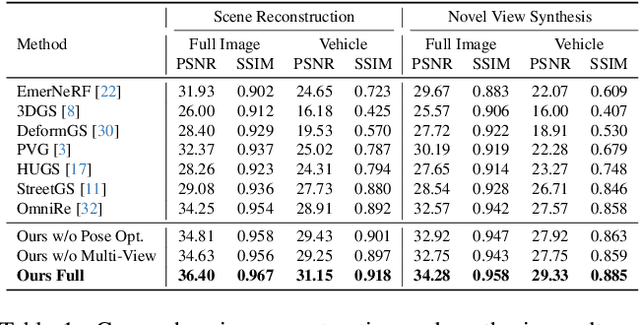
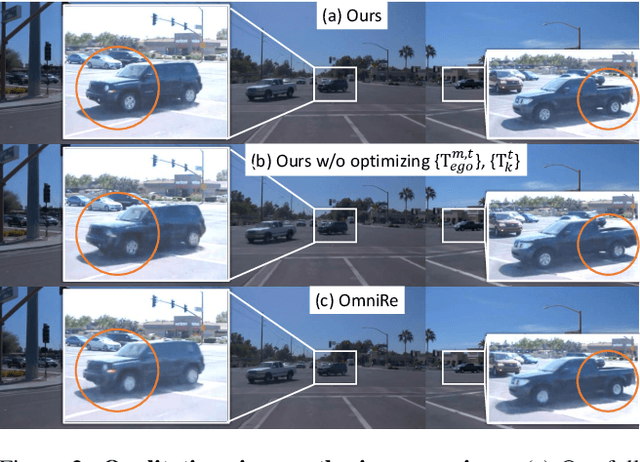
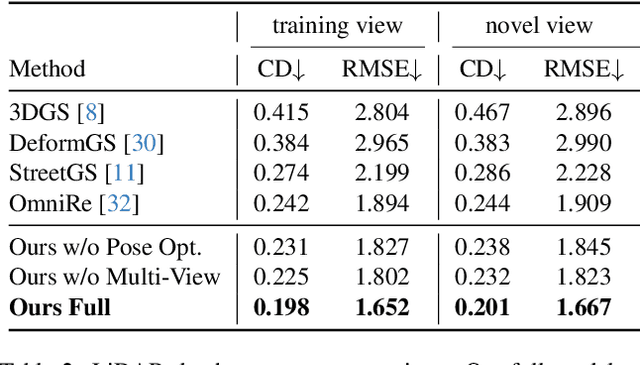
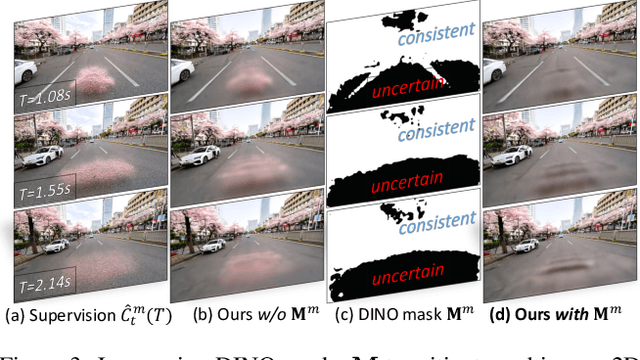
Abstract:Urban scene reconstruction requires modeling both static infrastructure and dynamic elements while supporting diverse environmental conditions. We present \textbf{StyledStreets}, a multi-style street simulator that achieves instruction-driven scene editing with guaranteed spatial and temporal consistency. Building on a state-of-the-art Gaussian Splatting framework for street scenarios enhanced by our proposed pose optimization and multi-view training, our method enables photorealistic style transfers across seasons, weather conditions, and camera setups through three key innovations: First, a hybrid embedding scheme disentangles persistent scene geometry from transient style attributes, allowing realistic environmental edits while preserving structural integrity. Second, uncertainty-aware rendering mitigates supervision noise from diffusion priors, enabling robust training across extreme style variations. Third, a unified parametric model prevents geometric drift through regularized updates, maintaining multi-view consistency across seven vehicle-mounted cameras. Our framework preserves the original scene's motion patterns and geometric relationships. Qualitative results demonstrate plausible transitions between diverse conditions (snow, sandstorm, night), while quantitative evaluations show state-of-the-art geometric accuracy under style transfers. The approach establishes new capabilities for urban simulation, with applications in autonomous vehicle testing and augmented reality systems requiring reliable environmental consistency. Codes will be publicly available upon publication.
ReconDreamer: Crafting World Models for Driving Scene Reconstruction via Online Restoration
Nov 29, 2024



Abstract:Closed-loop simulation is crucial for end-to-end autonomous driving. Existing sensor simulation methods (e.g., NeRF and 3DGS) reconstruct driving scenes based on conditions that closely mirror training data distributions. However, these methods struggle with rendering novel trajectories, such as lane changes. Recent works have demonstrated that integrating world model knowledge alleviates these issues. Despite their efficiency, these approaches still encounter difficulties in the accurate representation of more complex maneuvers, with multi-lane shifts being a notable example. Therefore, we introduce ReconDreamer, which enhances driving scene reconstruction through incremental integration of world model knowledge. Specifically, DriveRestorer is proposed to mitigate artifacts via online restoration. This is complemented by a progressive data update strategy designed to ensure high-quality rendering for more complex maneuvers. To the best of our knowledge, ReconDreamer is the first method to effectively render in large maneuvers. Experimental results demonstrate that ReconDreamer outperforms Street Gaussians in the NTA-IoU, NTL-IoU, and FID, with relative improvements by 24.87%, 6.72%, and 29.97%. Furthermore, ReconDreamer surpasses DriveDreamer4D with PVG during large maneuver rendering, as verified by a relative improvement of 195.87% in the NTA-IoU metric and a comprehensive user study.
The USTC-NERCSLIP Systems for the CHiME-8 NOTSOFAR-1 Challenge
Sep 03, 2024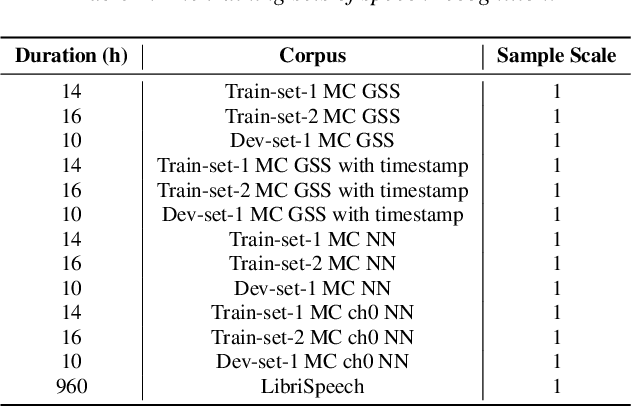
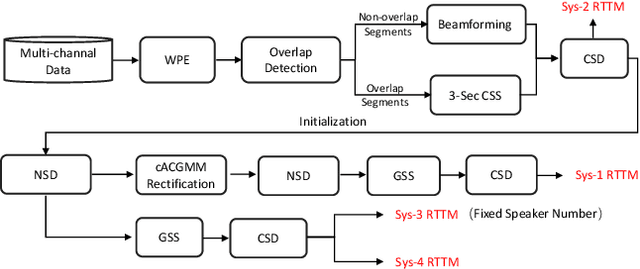
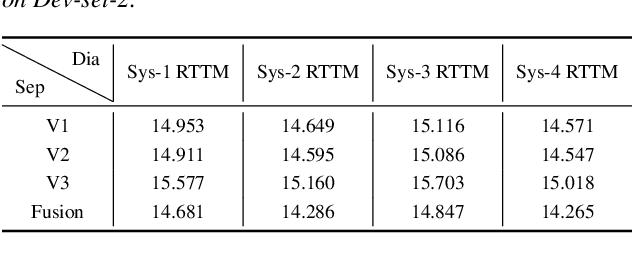
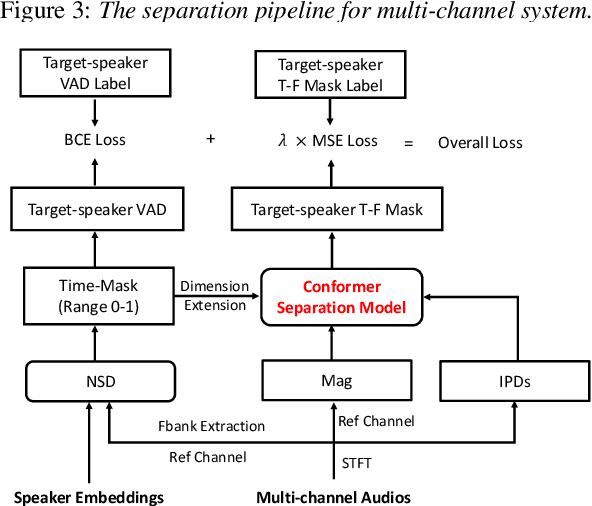
Abstract:This technical report outlines our submission system for the CHiME-8 NOTSOFAR-1 Challenge. The primary difficulty of this challenge is the dataset recorded across various conference rooms, which captures real-world complexities such as high overlap rates, background noises, a variable number of speakers, and natural conversation styles. To address these issues, we optimized the system in several aspects: For front-end speech signal processing, we introduced a data-driven joint training method for diarization and separation (JDS) to enhance audio quality. Additionally, we also integrated traditional guided source separation (GSS) for multi-channel track to provide complementary information for the JDS. For back-end speech recognition, we enhanced Whisper with WavLM, ConvNeXt, and Transformer innovations, applying multi-task training and Noise KLD augmentation, to significantly advance ASR robustness and accuracy. Our system attained a Time-Constrained minimum Permutation Word Error Rate (tcpWER) of 14.265% and 22.989% on the CHiME-8 NOTSOFAR-1 Dev-set-2 multi-channel and single-channel tracks, respectively.
Boosting Binary Neural Networks via Dynamic Thresholds Learning
Nov 04, 2022



Abstract:Developing lightweight Deep Convolutional Neural Networks (DCNNs) and Vision Transformers (ViTs) has become one of the focuses in vision research since the low computational cost is essential for deploying vision models on edge devices. Recently, researchers have explored highly computational efficient Binary Neural Networks (BNNs) by binarizing weights and activations of Full-precision Neural Networks. However, the binarization process leads to an enormous accuracy gap between BNN and its full-precision version. One of the primary reasons is that the Sign function with predefined or learned static thresholds limits the representation capacity of binarized architectures since single-threshold binarization fails to utilize activation distributions. To overcome this issue, we introduce the statistics of channel information into explicit thresholds learning for the Sign Function dubbed DySign to generate various thresholds based on input distribution. Our DySign is a straightforward method to reduce information loss and boost the representative capacity of BNNs, which can be flexibly applied to both DCNNs and ViTs (i.e., DyBCNN and DyBinaryCCT) to achieve promising performance improvement. As shown in our extensive experiments. For DCNNs, DyBCNNs based on two backbones (MobileNetV1 and ResNet18) achieve 71.2% and 67.4% top1-accuracy on ImageNet dataset, outperforming baselines by a large margin (i.e., 1.8% and 1.5% respectively). For ViTs, DyBinaryCCT presents the superiority of the convolutional embedding layer in fully binarized ViTs and achieves 56.1% on the ImageNet dataset, which is nearly 9% higher than the baseline.
Structured Pruning of Recurrent Neural Networks through Neuron Selection
Jun 17, 2019
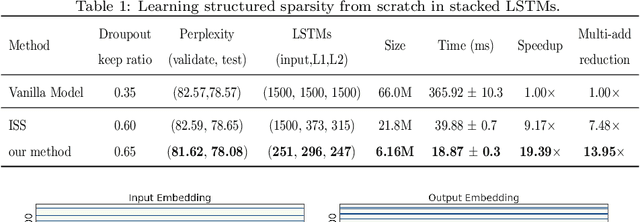

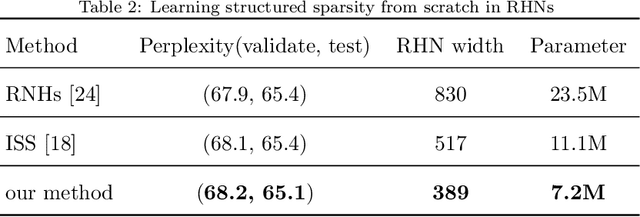
Abstract:Recurrent neural networks (RNNs) have recently achieved remarkable successes in a number of applications. However, the huge sizes and computational burden of these models make it difficult for their deployment on edge devices. A practically effective approach is to reduce the overall storage and computation costs of RNNs by network pruning techniques. Despite their successful applications, those pruning methods based on Lasso either produce irregular sparse patterns in weight matrices, which is not helpful in practical speedup. To address these issues, we propose structured pruning method through neuron selection which can reduce the sizes of basic structures of RNNs. More specifically, we introduce two sets of binary random variables, which can be interpreted as gates or switches to the input neurons and the hidden neurons, respectively. We demonstrate that the corresponding optimization problem can be addressed by minimizing the L0 norm of the weight matrix. Finally, experimental results on language modeling and machine reading comprehension tasks have indicated the advantages of the proposed method in comparison with state-of-the-art pruning competitors. In particular, nearly 20 x practical speedup during inference was achieved without losing performance for language model on the Penn TreeBank dataset, indicating the promising performance of the proposed method
 Add to Chrome
Add to Chrome Add to Firefox
Add to Firefox Add to Edge
Add to Edge